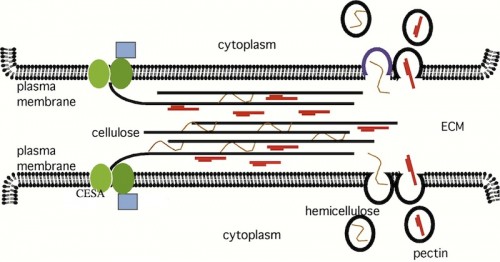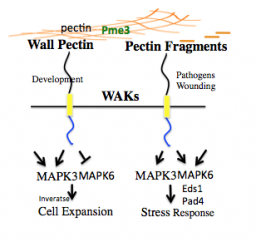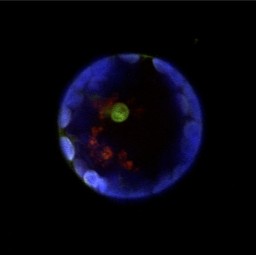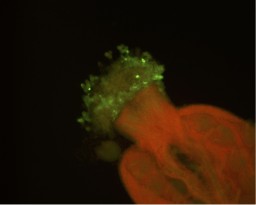Prof. Kohorn Wins NSF Grant to Investigate How Plant Cells Sense External Events
By Rebecca Goldfine
When biologist Bruce Kohorn 25 years ago “accidentally” stumbled upon an unknown protein that turned out to be critical for cell growth and for protecting plants from pathogens, it set him off on a long research trajectory. Over the years, he and his lab team have been solving bit by bit the mystery of how plant cells enlarge and also protect themselves against invading fungi and bacteria.
Recently the National Science Foundation awarded Kohorn a four-year grant for almost $600,000 to continue those studies, to investigate more deeply how the plant protein WAK, for wall-associated kinase, does its job. Kohorn is the Linnean Professor of Biology and Biochemistry at Bowdoin, and he is the director of the college’s biochemistry program. Kohorn told the NSF in his grant application, “We are poised to answer some long standing questions concerning WAKs, a receptor that has captured our imagination for over 20 years.”
U.S. Senators Susan Collins (R-Maine) and Angus King (I-Maine) released a joint statement about the grant, saying it “will provide Bowdoin’s skilled researchers and students with the opportunity to study a significant aspect of plants’ development. Maine’s colleges and universities are leaders in cutting-edge research, and funding for these projects helps train the next generation of researchers and promote scientific breakthroughs.”
When Kohorn talks about his research, he regularly uses the term “we,” referring to his lab team and, most importantly, to his wife and lab technician, Susan Kohorn. “She is a phenomenon, and she keeps the place running,” he said. Each year the Kohorns also mentor two or three Bowdoin students who work on smaller aspects of their project. Some of the new NSF money will support undergraduate fellowships and supply money for students to pursue research projects over the summer and academic year.
The Project
Kohorn’s lab focuses on the cell walls of plants, particularly those of the well-studied Arabidopsis, a model organism in biology. The cell walls, a matrix of cellulose and pectin, give plants their structure and support and also protect them against pathogens. The wall must be permeable enough to permit the flow of water and nutrients into the cell to increase internal pressure, or turgor, which contributes to plant growth. At the same time, the wall must keep destructive elements out.

“Pathogens want to get inside the cell to use their nutrients for growth, so they have enzymes that digest the cell wall and damage it,” Kohorn said. “The plant has a response to that damage. It senses that there is damage to the cell wall and mounts a response and tries to kill the bacteria or fungus.”
The Kohorns are trying to better understand the mechanisms that allow the cell to sense external conditions in order to regulate its internal pressure as well as launch a pathogen response when needed.

They have found that WAKs play a big part in both these jobs. A WAK is a cell-surface protein that senses the state of the cell wall and transmits a signal to the cell interior to adjust growth rates, or to mount a pathogen response. It specifically attaches to the pectin in the cell wall. “We can pretty much call it a pectin receptor now, as it senses the state of pectin,” Kohorn said.
And pectin is a target of pathogen attacks on cells. “What some pathogens do is take pectin and fragment it into little pieces,” Kohorn explained. “It turns out WAKs are bound to long strands of pectin as a plant grows, and this regulates correct cell enlargement. But WAKs bind preferentially to the little fragments when they are generated by pathogens, and the cell then switches its response to activate a whole series of events that try and take care of the pathogen.”
The question Kohorn’s lab will study in this stage of research is how WAKs distinguish between the regular wall pectin and the fragmented pectin. They’ll also research the subsequent activation pathways that trigger either cell expansion or a stress response.

- WAK (in green) being synthsized inside a cell

Questions of Applicability
Kohorn said he is interested in doing “basic biology” rather than having an immediate need to find a real-world use for his research. When he was at Duke University — where he was a professor for 14 years before coming to Bowdoin — he said biologists like him were under quite a bit of pressure to obtain research funding, and one source of money was from private biotech companies.
Agricultural industrialists and biofuel developers are both interested in plant physiology and cell wall research. Agriculturalists want to know how plants mount stress responses to pathogens or other disruptions. Biofuel developers are interested in learning more about such things as which plants are most suitable for biofuel and how to engineer plants so their cellulose is more accessible.
Indeed, the growing interest in biofuels has led to a stream of Department of Energy, U.S. Department of Agriculture and corporate research funding for scientists working in Kohorn’s area. “What we know about cell walls has just blossomed in the last 10-15 years,” he said.
Kohorn acknowledges that his research could be helpful to these fields. “Yes, it helps if we understand how plants respond to pathogens,” he said. “So you could come up with a product somehow, you could come up with a protective agent somehow.”
However, his goal is not to land upon a finding that could further one industry or another. Doing science purely to seek knowledge is critical, he argues, and one that is still recognized by the NSF as important to support. “The NSF funds basic science, they’re not looking for an applied product,” Kohorn said, adding, “Most of the innovation for applications come from basic research, and funding things that seemingly would have no application.”



